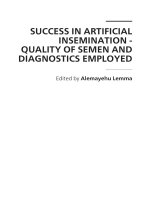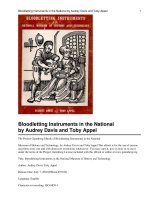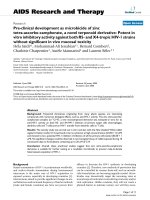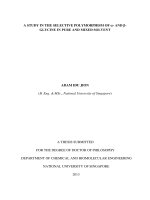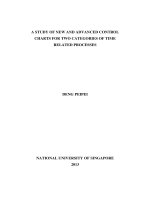In vitro antagonistic activity of fungal and bacterialbio control agents against chilli fruit rot incited by Colletotrichum Capsici
Bạn đang xem bản rút gọn của tài liệu. Xem và tải ngay bản đầy đủ của tài liệu tại đây (422.68 KB, 9 trang )
Int.J.Curr.Microbiol.App.Sci (2019) 8(5): 190-198
International Journal of Current Microbiology and Applied Sciences
ISSN: 2319-7706 Volume 8 Number 05 (2019)
Journal homepage:
Original Research Article
/>
In vitro Antagonistic Activity of Fungal and Bacterialbio Control Agents
against Chilli Fruit Rot Incited by Colletotrichum capsici
N. Kavi Bharathi1, N. Revathy1*, E.G. Ebenezar1 and R.P. Gnanamalar2
1
Department of Plant Pathology, 2Department of Plant Breeding and Genetics, Agricultural
College and Research Institute, Madurai, India
*Corresponding author
ABSTRACT
Keywords
Chilli,
Colletotrichum
capsici, Biocontrol,
Dual plate
Article Info
Accepted:
04 April 2019
Available Online:
10 May 2019
In this study, antagonistic effect of 6 isolates of Bacillus subtilis (Bs-1, Bs-2, Bs-3, Bs-4,
Bs-5,Bs-6), Pseudomonas fluorescens (Pf-1, Pf-2, Pf-3, Pf-4, Pf-5, Pf-6), Saccharomyces
cerevisiae (Sc-1, Sc-2, Sc-3, Sc-4, Sc-5, Sc-6) and Trichoderma spp. (Ts-1, Ts-2, Ts-3, Ts4, Ts-5, Ts-6) were evaluated against Colletotrichum capsici, the causal agent of chilli fruit
rot, as potential biocontrol agents under in vitro conditions. Fungal and bacterial biocontrol
agents were tested against chilli fruit rot pathogen (C.capsici) by dual culture plate assay.
Among the biocontrol agents tested Bacillus subtilis showed 62.22 % inhibition against the
target pathogen followed by Pseudomonas fluorescens (58.88 %), Saccharomyces
cerevisiae (56.66 %) and Trichoderma spp (54.44 %) in the dual-culture assay under in
vitro conditions.
green and ripe chilli fruits contains an
alkaloid capsaicin, which are used to impart
pungency into the various food preparations,
it is used in pharmaceutical industries,
cosmetics, preparation of oleoresin and other
industrial resources (Bosland and Votava,
2003). Chilli is susceptible to many foliar and
soil borne fungal diseases among the biotic
stress, fruit rot caused by Colletotrichum
capsici is one of the most destructive disease
which causes heavy yield loss in almost all
chilli growing areas. The symptoms of the
disease were noticed on leaves, flowers and
Introduction
Chilli is considered as one of the most
important commercial spice crops and as it is
so widely used it has been given the name
wonder spice. Chilli (Capsium annuum)
belonging to the family Solanaceae is the
most
commonly cultivated
and
an
indispensable source of vegetable and spice
across the tropical and subtropical regions of
the world. India is the second largest
producer, consumer and exporter of chilli.
Chillies are used for various purposes, both
190
Int.J.Curr.Microbiol.App.Sci (2019) 8(5): 190-198
fruits. The disease incited as dark spot, watersoaked lesions that rapidly expand. In some
cases, the lesions are brown, and then turn
black due to the formation of setae and
sclerotia (Roberts, 2001). Bio control is an
effective alternate that provide disease
control, while being relatively harmless to
humans, selective in mode of action, difficult
for pathogens to develop resistance (Singh et
al., 2005).In the present study shows the role
of fungal and bacterial biocontrol agents
against Colletotrichum capsici under in vitro
which will effective in the field level.
dextrose media in Petri dish for isolation of
the antagonists.
Materials and Methods
Healthy chilli plants were pulled out gently
with intact roots and the excess soil adhering
on roots were removed gently. Ten gram of
rhizosphere soil was transferred to 250 ml
Erlenmeyer flask containing 100 ml of sterile
distilled water. After thorough shaking, the
antagonist in the suspension was isolated by
using serial dilution plate method (Pramer and
Schmidt, 1956). From the final dilutions of
10-3, l0-5 and 10-6 one ml of each aliquot was
pipetted out, poured in sterilized Petri plate
containing Trichoderma selective medium.
Trichoderma spp. isolated on TSM, were
purified and maintained on PDA medium.
The pure cultures were maintained on
respective agar slants at4 °C.
The plates were incubated at 28±2°C for 2448 hr or until colony formation. Selection of
single bacterial and fungal colonies was done
based on morphological variation, colony
characters and confirmed by different
biochemical tests and after purification they
were preserved in refrigerator.
Isolation of fungal
rhizosphere region
Colletotrichum capsici isolate was collected
from fruit rot infected chilli plants in
Chellampatti village of Madurai, Tamil Nadu
by tissue segment method (Rangaswami and
Mahadevan, 1999).
The isolate was confirmedby morphological
appearance and by ITCC (Accession no:
10025.19). A single pure culture was prepared
from the isolate and maintained in PDA slants
used for further experiments.
Isolation of bacterial and yeast antagonists
from phylloplane region of chilli plants
Healthy and fruit rot infected chilli fruit
samples, at ripening stage, were collected
from different chilli growing areas of Tamil
Nadu. For isolation of antagonist, two grams
of each sample were surface sterilized and
blot dried.
antagonist
from
Effect of bacterial antagonists on the
growth of Colletotrichum capsici under in
vitro
Six isolates of Bacillus subtilis and
Pseudomonas fluorescens and were tested for
their antagonistic effect on growth of
Colletotrichum capsici by dual culture
technique (Dennis and Webster, 1971). The
bacterial isolates were streaked on one side of
the Petri dish (1 cm away from the edge of the
plate) on PDA medium and a mycelial disc (9
mm
diameter)
of
nine
days
old
Colletotrichum capsici culture was placed on
the opposite side of the Petri dish
Cut pieces of samples (5mm) were taken into
250 ml Erlenmeyer flask with 20 ml of sterile
distilled water. After 24 hr of shaking with an
orbital shaker at 150 rpm at 28±2°C, (10-1 to
10-8) serial dilutions of the suspension was
made. Small aliquots (50 µl) from dilutes of
10-7 and 10-8were poured onto Kings B agar,
nutrient agar, and Yeast extract peptone
191
Int.J.Curr.Microbiol.App.Sci (2019) 8(5): 190-198
perpendicular to the bacterial streak. The
plates were incubated at room temperature
(28±2°C) for 9 days. Three replications were
maintained for each isolate. After nine days of
incubation, the pathogen growth and
inhibition zone were measured.
Results and Discussion
Effect of Bacillus subtilis on the growth of
Colletotrichum capsici under in vitro
Among the six isolates of B. subtilis (Bs-3)
isolate was found to record maximum growth
reduction of Colletotrichum capsici by 62.22
percent over control which was followed by
B.subtilis (Bs- 4), which recorded the growth
reduction of 55.55 per cent. The least
mycelial growth reduction was recorded by
B.subtilis (Bs-5) with 36.67 per cent (Table 1;
Plate 1).
Effect of fungal antagonists on the growth
of Colletotrichum capsici under in vitro
Six isolates of Trichoderma spp. and
Saccharomyces cerevisiae were screened
against Colletotrichum capsici by dual culture
method. A nine mm disc of Colletotrichum
capsici and test antagonists viz., Trichoderma
spp. disc was placed and Saccharomyces
cerevisiae was streaked opposite to pathogen
disc near the periphery of the Petri plate and
incubated at room temperature (28±2°C).
Three replications were maintained for each
isolate. The medium inoculated with the
pathogen alone served as control. When the
plates attained the full growth, the radial
growth of the pathogen was measured in the
others treatments. After nine days of
incubation, mycelial growth of the pathogen
and inhibition zone were measured in treated
as well as control plates. Percent inhibition
(PI) of mycelial growth was calculated using
the formula suggested by(Pandey and
Vishwakarma,1998).
Effect of Pseudomonas fluorescens on the
growth of Colletotrichum capsici under in
vitro
Six P.fluorescens isolates were tested against
the growth of Colletotrichum capsici by dual
culture experiment. Among the isolates, P.
fluorescens (Ps-1) resulted maximum growth
reduction of Colletotrichum capsici by 58.88
per cent over control which was followed by
P. fluorescens (Ps-6) which recorded the
growth reduction of 55.55 per cent over
control. The minimum growth reduction of
40.00 per cent was observed in P. fluorescens
(Ps-2) (Table 2; Plate 2).
Effect of Saccharomyces cerevisiae on the
growth of Colletotrichum capsici under in
vitro
Dc – Dt
PI =
× 100
Dc
The effect of six isolates of Saccharomyces
cerevisiae was tested against Colletotrichum
capsici
under
in
vitro
conditions.
Saccharomyces cerevisiae (Sc-3) was found
to be effective by recording maximum
mycelial growth reduction of 56.66 per cent
over control which was followed by (Sc-1)
which recorded the growth reduction of 54.44
per cent. The least mycelial growth reduction
was recorded by (Sc-6) with 33.33 per cent
(Table 3; Plate 3).
Dc = Average diameter of fungal growth (cm)
in control
Dt = Average diameter of fungal growth (cm) in
treatment.
The growth of antagonist over the pathogen
was measured nine days after incubation. The
growth and zone of inhibition was measured
and expressed in cm.
192
Int.J.Curr.Microbiol.App.Sci (2019) 8(5): 190-198
phyllosphere of the Nile River in India by
(Nair et al., 2002). Thirty B. subtilis isolates
were evaluated under in vitro against C.
capsici. All the isolates recorded the varied
level of inhibition of mycelial growth of C.
capsici. Among different isolates, BS16
showed maximum inhibition of 63.42 per cent
followed by BS 30 (57.40 %) and minimum
was 11.98 per cent (Rajkumar et al., 2018).
Effect of Trichoderma spp. on the growth of
Colletotrichum capsiciin vitro
The effect of six isolates of Trichoderma spp.
were tested against Colletotrichum capsici
under in vitro conditions. Among the
antagonists tested, Trichoderma spp. (Ts-4)
was found to be effective by recording
maximum mycelial growth reduction of 56.66
per cent over control which was followed by
Trichoderma spp. (Ts-2) which recorded the
growth reduction of 52.22 per cent. The least
mycelial growth reduction was recorded by
Trichoderma spp. (Ts-3) with 43.33 per cent
(Table 4; Plate 4).
In the present investigation, P.fluorescens
isolates were tested against the growth of
Colletotrichum capsici by dual culture
experiment. Among the isolates, P. fluorescens
(Ps-6) resulted maximum growth reduction of
Colletotrichum capsici by 58.88 per cent over
control which was followed by P. fluorescens
(Ps-1) which recorded the growth reduction of
55.55 per cent over control.
Effect of bacterial antagonists on the
growth of Colletotrichum capsici isolate
under in vitro
In the present study, B. subtilis(Bs-3) isolate
was found to record maximum growth
reduction of Colletotrichum capsici by 62.22
percent over control which was followed by
B.subtilis (Bs- 4), which recorded the growth
reduction of 55.55 percent. Jeyalakshmi et
al.,(1998) reported that Bacillus subtilis was
used to control chilli fruit rot and die back.A
novel Bacillus spp. AB1, with strong
antifungal activity, was obtained from coffee
Similar results were reported by Birari et al.,
(2018) and showed that Pseudomonas
flourescens have90% of the radial growth
inhibition of the pathogen Colletotrichum
capsici. Linu et al., (2006) stated that the
antagonistic effect of the bacterial isolates
was tested against the chilli anthracnose
pathogen Colletotrichum capsici by the
standard dual culture method.
Table.1 Effect of Bacillus subtilis against the growth of Colletotrichum capsici under in vitro
conditions
S.No
Isolate code
1
2
3
4
5
6
7
Bs - 1
Bs - 2
Bs – 3
Bs - 4
Bs – 5
Bs - 6
Control
CD (P=0.05)
Radial mycelial
growth (cm)*
5.00
4.40
3.80
4.00
5.70
5.50
9.00
0.25
*Mean of three replications
193
Per cent inhibition
over control
44.44
52.22
62.22
55.55
36.67
38.88
0.00
Int.J.Curr.Microbiol.App.Sci (2019) 8(5): 190-198
Table.2 Effect of Pseudomonas fluorescens against the growth of Colletotrichum capsici under
in vitro conditions
S.No
Isolate code
1
2
3
4
5
6
7
Pf – 1
Pf – 2
Pf – 3
Pf – 4
Pf – 5
Pf – 6
Control
CD (P=0.05)
Radial mycelial
growth(cm)*
3.70
5.60
5.00
4.30
4.50
4.00
9.00
0.20
Per cent inhibition
over control
58.88
37.77
44.44
52.22
50.00
55.55
0.00
*Mean of three replications
Table.3 Effect of Saccharomyces cerevisiae against the growth of Colletotrichum capsici under
in vitro conditions
S.No
Isolate code
1
2
3
4
5
6
7
Sc – 1
Sc – 2
Sc – 3
Sc – 4
Sc – 5
Sc – 6
Control
CD (P=0.05)
Radial mycelial
growth (cm)*
4.10
5.00
3.90
5.40
4.30
6.00
9.00
0.95
Per cent inhibition
over control
54.44
44.44
56.66
40.00
52.22
33.33
0.00
*Mean of three replications
Table.4 Effect of Trichoderma spp. against the growth of Colletotrichum capsici under in vitro
conditions
S.No
Isolate code
1
2
3
4
5
6
7
Ts – 1
Ts – 2
Ts – 3
Ts – 4
Ts – 5
Ts – 6
Control
CD (P=0.05)
Radial mycelial
growth (cm)*
4.90
4.30
5.10
4.10
4.80
5.00
9.00
0.22
*Mean of three replications
194
Per cent inhibition
over control
45.55
52.22
43.33
54.44
46.66
44.44
-
Int.J.Curr.Microbiol.App.Sci (2019) 8(5): 190-198
Plate.1 Effect of Bacillus subtilis on the growth of Colletotrichum capsici
1. Bs - 1
4. Bs - 4
7. Control
2.Bs - 2
3.Bs - 3
5.Bs - 5 6.Bs - 6
Plate.2 Effect of Pseudomonas fluorescens on the growth of Colletotrichum capsici
1. Ps - 1
4. Ps - 4
7. Control
2.Ps - 3
5.Ps - 5
195
3.Ps - 3
6. Ps - 6
Int.J.Curr.Microbiol.App.Sci (2019) 8(5): 190-198
Plate.3 Effect of Saccharomyces cerevisiae on the growth of Colletotrichum capsici
1. Sc - 1
2.Sc - 2 3.Sc– 3
4. Sc - 45.Sc - 5
6. Sc – 6
7.Control
Plate.4 Effect of Trichoderma spp. on the growth of Colletotrichum capsici
1. Ts - 1
4. Ts - 4
7. Control
2.Ts - 2
5.Ts - 5
3.Ts - 3
6. Ts - 6
The results revealed that among the isolates
PS 2 showed maximum inhibition of 93.41%
whereas the other isolate PS 3 showed 72.5%
of inhibition against Colletotrichum capsici
after 7 days of incubation.The biological
control
of
three
Colletotrichum
196
Int.J.Curr.Microbiol.App.Sci (2019) 8(5): 190-198
lindemuthianum races using Pseudomonas
chlororaphis PCL1391 and Pseudomonas
fluorescens WCS365(Bardas et al., 2009).
Moreover, L24 and LFA802 isolates were less
effective (Liu et al., 2018).
Effect of Trichoderma spp. on the growth of
Colletotrichum capsici in vitro
The plants sprayed with only C. capsici
cultures, recorded the highest disease
intensity and P. fluorescens sprayed plant
recorded least infection, this suppression of
disease was attributed either to the activity of
antifungal compounds produced by the
microbe or the hyper parasitism on the
pathogen or by ISR in the host plant which
combat the pathogen infection. The rapid
defense exerted by the treatment at the site of
fungal entry delayed the infection process
(Ramkumar et al., 2012).
In the present study, the fungal antagonist
Trichoderma spp. (Ts-4) was found to be the
most effective by recording maximum
mycelial growth reduction of 56.66 per cent at
9 DAI. Azad et al., (2013) found that
Trichoderma viride gives 77.60% growth
inhibition against C. gloeosporioides. The
inhibitory effect of volatile and non-volatile
compounds released by T. saturnisporum, T.
harzianum, T. viride and T. reesei against
Colletotrichum capsici, a fungal pathogen
responsible for anthracnose disease in bell
peppers (Ajith and Lakshmidevi, 2010).
Evaluated different Trichoderma strains
against
Colletotrichum
capsici
under
laboratory conditions by different techniques
and found the T. harzianum as potential
antagonist for inhibition of the mycelial
growth, conidial germination, germ tube
elongation and disease severity of C. capsici
(Rahman et al., 2013).
Effect of Saccharomyces cerevisiae on the
growth of Colletotrichum capsici under in
vitro
Biological
control
agents
such
as
Saccharomyces cerevisiae have been reported
as antagonistic to C. capsici (Jayelakshmi and
Seetharaman, 1998). The results of present
experiment revealed that Saccharomyces
cerevisiae (Sc-3) was found to be effective by
recording maximum mycelial growth
reduction of 56.66 per cent over control
which was followed by (Sc-1) which recorded
the growth reduction of 54.44 per cent. Lopes
et al., (2015)Co-cultured C. acutatum in Petri
dishes with each S. cerevisiae yeast isolate
and observed that all yeast isolates inhibited
mycelial growth of C. acutatum. The ACBCAT1 and ACB-CR1 isolates promoted the
most inhibitions values correspond to 71%
and 67%, respectively. Moreover, the ACBPE2 and ACB-K1 isolates were the least
effective. Three yeast isolates were isolated
and showed antagonistic effect of mycelial
growth of C. gloeosporioides and showed
different Inhibition ability relative to the
control treatment when cocultured with C.
gloeosporioides. GA8 isolate exhibited
highest inhibition values of 79.29%.
References
Ajith, P. S., and Lakshmidevi, N. (2010). Effect of
volatile and non-volatile compounds from
Trichoderma spp. against Colletotrichum
capsici incitant of anthracnose on bell
peppers. Nature and Science, 8(9), 265-269.
Azad, C. S., Srivastava, J. N., and CHAND, G.
(2013). Evaluation of bio-agents for
controlling fruit rot/anthracnose of banana
caused by Colletotrichum gloeosporioides
in-vitro condition. The Bioscan, 8(4), 12211224
Bardas, G. A., Lagopodi, A. L., Kadoglidou, K.,
and Tzavella-Klonari, K. (2009). Biological
control
of
three
Colletotrichum
lindemuthianum races using Pseudomonas
chlororaphis PCL1391 and Pseudomonas
fluorescens WCS365. Biological Control,
49(2), 139-145.
197
Int.J.Curr.Microbiol.App.Sci (2019) 8(5): 190-198
Birari, B. P., Gade, R. M., and Chuodhari, R. K.
(2018). Antifungal efficacy of plant
extracts,
biocontrol
agents
against
Colletotrichum capsici causing anthracnose
of chilli. Journal of Pharmacognosy and
Phytochemistry, 7(5), 1368-1373.
Bosland, P. W., and Votava, E. J. (2003). Peppers:
vegetable and spice capsicums. CAB
International.
Dennis, C., and Webster, J. (1971). Antagonistic
properties
of
species-groups
of
Trichoderma: II. Production of volatile
antibiotics. Transactions of the British
Mycological Society, 57(1), 41-IN4
Jeyalakshmi, C., and Seetharaman, K. (1998).
Biological control of fruit rot and dieback
of chilli with plant products and
antagonistic
microorganism.
Disease
Research. 12, 46–48.
Linu, M. S., Jisha, M. S., and Jisha, M. S. (2006).
In vitro control of Colletotrichum capsici
induced chilli anthracnose by fungicides
and biocontrol agent. Int. J. Appl. Pure Sci.
Agric, 3, 27-33.
Liu, Z., Du, S., Ren, Y., and Liu, Y. (2018).
Biocontrol ability of killer yeasts
(Saccharomyces cerevisiae) isolated from
wine
against
Colletotrichum
gloeosporioides on grape. Journal of basic
microbiology, 58(1), 60-67.
Lopes, M. R., Klein, M. N., Ferraz, L. P., da
Silva, A. C., and Kupper, K. C. (2015).
Saccharomyces cerevisiae: a novel and
efficient biological control agent for
Colletotrichum acutatum during preharvest. Microbiological research, 175, 9399.
Nair, J. R., Singh, G., and Sekar, V. (2002).
Isolation and characterization of a novel
Bacillus strain from coffee phyllosphere
showing antifungal activity. Journal of
applied microbiology, 93(5), 772-780.
Pandey, K. K., and Vishwakarma, S. N. (1998).
Growth, sporulation and colony characters
of Alternaria alternata on different
vegetable-based
media.
Journal
of
Mycology and Plant Pathology (India).
Pramer, D., and Schmidt, E. L. (1956). Exp. Soil
Micro.
Rahman, M. A., Razvy, M. A., and Alam, M. F.
(2013).
Antagonistic
activities
of
Trichoderma
strains
against
chili
anthracnose pathogen. Int. J. Microbiol.
Mycol, 1(1), 7-22.
Rajkumar, K., Naik, M.K., Amaresh, Y.S., and
Chennappa, G. (2018). Bioefficacy of
Bacillus subtilis against Major Pathogen of
Chilli Colletotrichum capsici Causing Fruit
Rot of Chilli. Int.J.Curr.Microbiol.App.Sci.,
7(7): 2681-2686
Ramkumar, R., Soureche, S., Prabhakar and
Muthuraman Pandurangan. (2012). Role of
antagonistic
microbe
Pseudomonas
fluorescens on Colletotrichum capsici
infecting
Curcuma
longa.
Plant
PatholMicrob. 3:7
Rangswamy, G., and Mahadevan, A. (1999).
Diseases of Crop Plants in India Prentice
Hall India Pvt. Ltd., New Delhi.
Roberts, P. D. (2001). Anthracnose caused by
Colletotrichum sp. on pepper. University of
Florida Cooperative Extension Service,
Institute of Food and Agricultural Sciences,
EDIS.
Singh, S., Prajapati, R. K., and Srivastava, S. S. L.
(2005). Efficacy of fungicides against
Sclerotium rolfsii causing collar rot in
lentil. Farm Sci J, 14(2), 68-69.
How to cite this article:
Kavi Bharathi, N., N. Revathy, E.G. Ebenezar and Gnanamalar, R.P. 2019. In vitro
Antagonistic Activity of Fungal and Bacterialbio Control Agents against Chilli Fruit Rot
Incited by Colletotrichum capsici. Int.J.Curr.Microbiol.App.Sci. 8(05): 190-198.
doi: />
198
